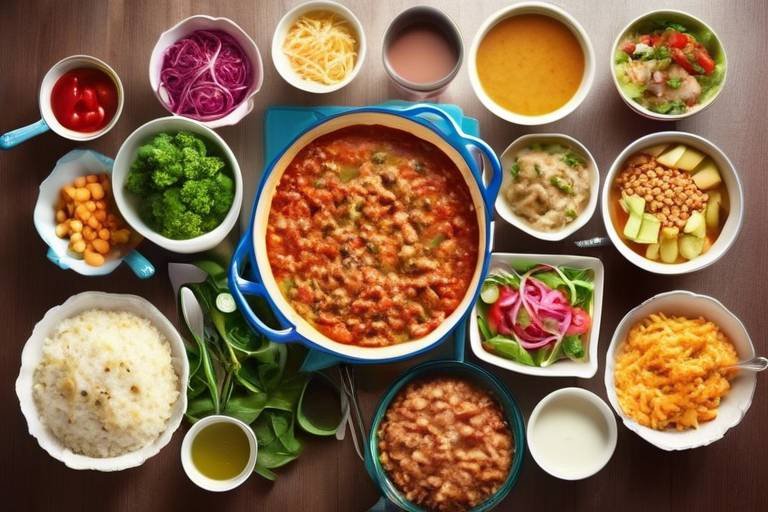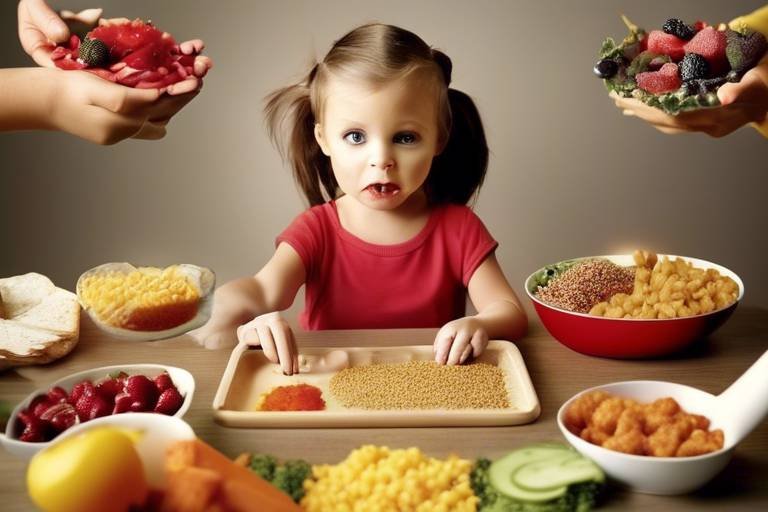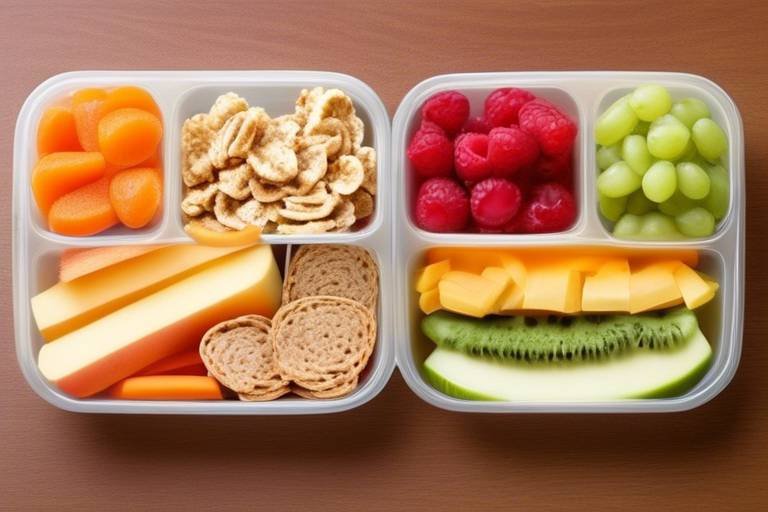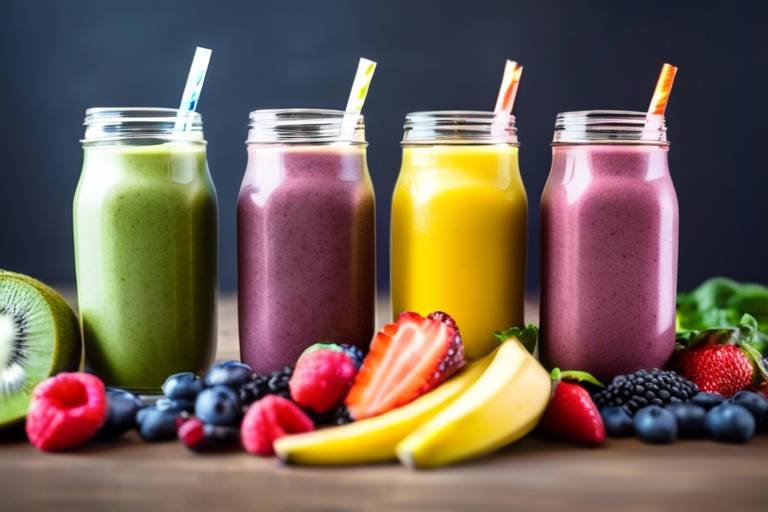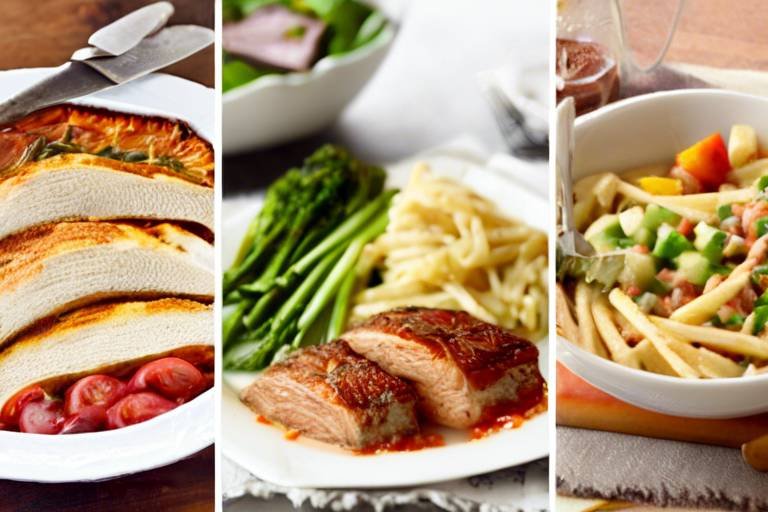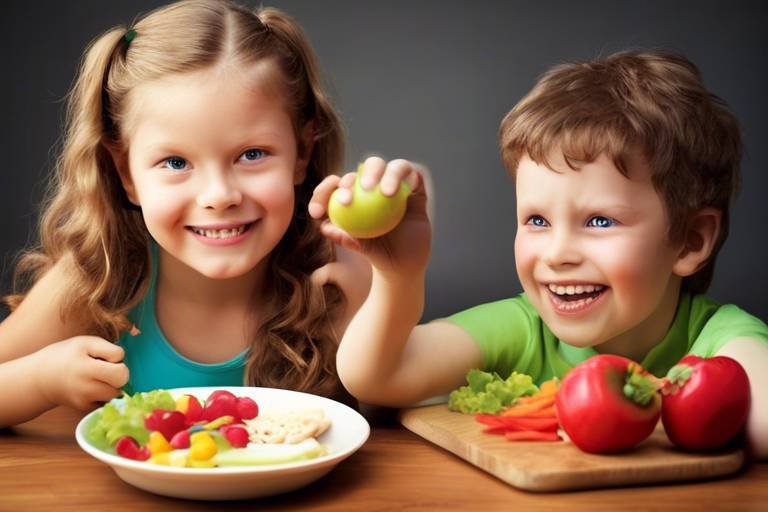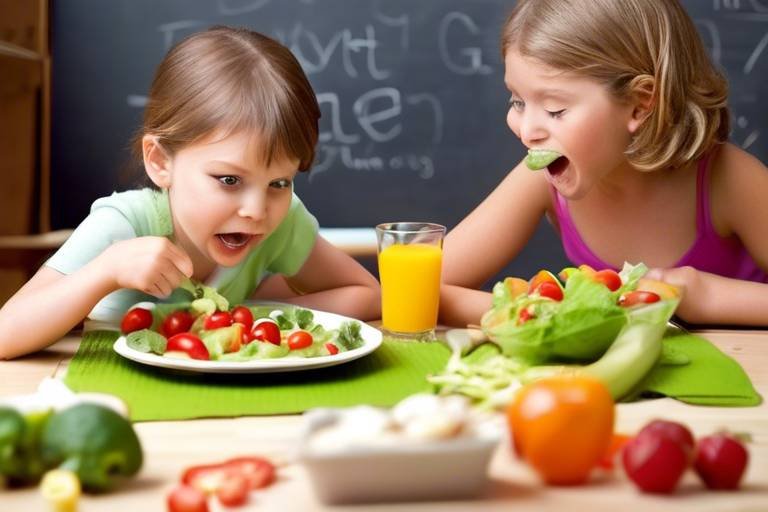A Guide to Food Portions for Kids
Understanding what and how much to feed our children can sometimes feel like navigating a maze. With the myriad of choices available, it’s essential to pinpoint the right food portions for kids to ensure they're getting the nutrition they need for healthy growth and development. This article serves as your friendly guide, packed with useful insights and practical tips. We’ll dive into the nutritional needs of children, recommended serving sizes, and ways to make healthy eating fun and engaging. So, let’s embark on this culinary journey together and explore how to make mealtime a delightful and nutritious experience for your little ones!
Children are not just mini-adults; they have unique nutritional requirements that evolve as they grow. The right balance of nutrients fuels their bodies and minds, helping them thrive in every aspect of life. Key nutrients such as carbohydrates, proteins, fats, vitamins, and minerals are essential for their development. For example, calcium is crucial for bone growth, while iron supports energy levels and cognitive function. But how do we ensure they’re getting these nutrients in the right amounts? This is where portion control comes into play. By understanding appropriate serving sizes, parents can help their kids meet these nutritional needs without overwhelming them with food.
Now that we understand the importance of nutrition, let's break down the recommended serving sizes for different food groups tailored specifically for children. It’s not just about what they eat, but also how much. Here’s a practical guide to ensure your kids get adequate nutrition without overeating:
| Food Group | Recommended Serving Size | Examples |
|---|---|---|
| Fruits | 1 cup | 1 medium apple, 1 banana, or 1 cup of berries |
| Vegetables | 1 cup | 1 cup of raw leafy greens or 1/2 cup of cooked vegetables |
| Grains | 1 ounce | 1 slice of bread, 1/2 cup of cooked rice, or 1 cup of cereal |
| Proteins | 2-3 ounces | 1 egg, 1/2 cup of beans, or 2 tablespoons of peanut butter |
This table serves as a quick reference for parents and caregivers, helping them make informed decisions about portion sizes. Remember, these are general guidelines; individual needs may vary based on age, activity level, and overall health.
Fruits and vegetables are the superheroes of your child’s diet. They are packed with essential vitamins, minerals, and fiber, which are vital for healthy growth. But how much should they be eating? The recommended serving size is about 1 cup of fruits and vegetables each day. This might sound like a lot, but it can be easily achieved with some creativity and planning!
Offering a variety of fruits and vegetables not only enhances nutrition but also keeps meals exciting for kids. Think of it as painting a colorful picture. The more colors you add, the more vibrant and appealing it becomes! Incorporating different types of fruits and veggies ensures that your kids receive a broad spectrum of nutrients. For instance, dark leafy greens provide iron, while orange vegetables like carrots are rich in beta-carotene.
Encouraging kids to eat more fruits and vegetables can sometimes feel like pulling teeth. But fear not! Here are some practical tips to make these foods more appealing:
- Make it fun: Create colorful fruit skewers or vegetable faces on their plates.
- Get them involved: Let kids help with grocery shopping and meal prep to spark their interest.
- Be a role model: Show enthusiasm for eating fruits and vegetables yourself.
Grains and proteins are essential components of a child's diet. They provide the energy needed for play and growth. The recommended serving sizes vary, but generally, children should have about 1 ounce of grains and 2-3 ounces of protein daily. Balancing these food groups can be as simple as pairing whole grain bread with lean meats or beans.
Healthy snacking plays a significant role in children's diets. It’s important to choose snacks wisely to support their overall well-being. Aim for snacks that are rich in nutrients rather than empty calories. Portion sizes for snacks should be smaller than meals, roughly around 1/2 to 1 cup depending on the food type.
Here are some nutritious snack ideas that are both appealing and easy to prepare:
- Yogurt with fresh fruit
- Whole grain crackers with cheese
- Vegetable sticks with hummus
- Popcorn (air-popped) with a sprinkle of cheese
Teaching children about portion control can help them develop healthy eating habits that last a lifetime. Here are some fun techniques to manage portion sizes:
- Use smaller plates: This can trick the mind into thinking they’re eating more.
- Encourage mindful eating: Teach them to listen to their hunger cues and eat slowly.
- Make it a game: Challenge them to fill half their plate with vegetables at each meal.
Q: How can I tell if my child is eating enough?
A: Pay attention to their energy levels, growth patterns, and overall health. Regular check-ups with a pediatrician can help monitor their nutritional intake.
Q: What if my child refuses to eat fruits and vegetables?
A: Keep trying! It can take multiple exposures before kids accept new foods. Try different preparation methods or involve them in cooking.
Q: Are there any foods I should avoid completely?
A: While it’s essential to limit processed foods high in sugar and unhealthy fats, it’s also important to teach balance. Occasional treats can be part of a healthy diet.

Understanding Nutritional Needs
When it comes to children's nutrition, understanding their unique needs is crucial for their growth and development. Kids are not just mini-adults; their bodies are constantly changing, and their nutritional requirements shift as they age and become more active. This means that what works for an adult might not be suitable for a child. For instance, a toddler's energy needs are significantly different from those of a pre-teen who is running around all day. So, how do we navigate these nutritional waters?
First and foremost, it’s important to recognize the fundamental nutrients that children need. These include:
- Carbohydrates: The primary energy source for kids, crucial for their active lifestyles.
- Proteins: Essential for growth, muscle development, and overall body repair.
- Fats: Important for brain development and energy, but should come from healthy sources.
- Vitamins and Minerals: Vital for various bodily functions, including immune support and bone health.
- Water: Often overlooked, but staying hydrated is key to maintaining energy levels and concentration.
To meet these nutritional needs, portion control becomes a vital tool for parents. It’s not just about what is served, but also how much. For example, a balanced plate for a child might look like this:
| Food Group | Recommended Portion | Examples |
|---|---|---|
| Fruits | 1/2 cup | Apple slices, berries, or banana |
| Vegetables | 1/2 cup | Carrot sticks, broccoli, or spinach |
| Grains | 1/2 cup cooked | Brown rice, whole grain pasta, or quinoa |
| Proteins | 1 ounce | Chicken, beans, or tofu |
It's also essential to consider the activity level of your child. A highly active child will require more calories and nutrients than one who is less active. Therefore, parents should pay attention to how their child’s energy levels fluctuate throughout the day and adjust their portion sizes accordingly. This way, kids can fuel their bodies appropriately without overdoing it.
Moreover, introducing a variety of foods can help ensure that children receive a well-rounded diet. Think of it like a rainbow on their plate! Each color represents different nutrients that contribute to their overall health. So, don’t be shy about mixing things up and trying new fruits and vegetables. You might be surprised at what they enjoy!
In conclusion, understanding your child's nutritional needs is not just about what they eat, but also about how much they eat. By focusing on balanced portions and encouraging a variety of foods, you can help set the foundation for a lifetime of healthy eating habits. Remember, you’re not just feeding them for today; you’re nurturing their growth for tomorrow!

Recommended Serving Sizes
When it comes to feeding children, understanding is crucial for ensuring they receive the right balance of nutrients without overeating. Children’s bodies are constantly growing and developing, which means their nutritional needs are dynamic and vary based on age, activity level, and overall health. The key to healthy eating is portion control, and knowing what constitutes a proper serving size can make a significant difference in a child’s diet.
For parents and caregivers, it can be overwhelming to determine how much food to offer. Fortunately, there are general guidelines that can help simplify this process. Below is a quick reference table that outlines the recommended serving sizes for various food groups tailored for children:
| Food Group | Recommended Serving Size | Examples |
|---|---|---|
| Fruits | 1 cup | 1 medium apple, 1 banana, or 1 cup of berries |
| Vegetables | 1 cup (raw or cooked) | 1 cup of leafy greens or 1 medium carrot |
| Grains | 1 ounce | 1 slice of bread, ½ cup of cooked rice or pasta |
| Protein | 2-3 ounces | 2-3 ounces of chicken, fish, or tofu |
| Dairy | 1 cup | 1 cup of milk or yogurt, 1.5 ounces of cheese |
By following these guidelines, parents can ensure that their children are getting a diverse range of nutrients essential for their growth and development. However, it’s important to remember that these serving sizes can vary based on individual needs. For instance, a very active child might require larger portions, while a less active child may need smaller servings.
Incorporating a variety of foods into meals is not just about nutrition; it’s also about keeping mealtime exciting! For instance, you can mix different fruits in a colorful fruit salad or create a rainbow plate with assorted vegetables. This not only makes the food visually appealing but also encourages kids to try new things. Remember, making meals fun can lead to healthier eating habits!
As you introduce these serving sizes, it’s also a good idea to engage your kids in discussions about nutrition. Ask them questions like, “What do you think is the healthiest food on your plate?” or “How many colors can you find in your meal?” This helps them develop a better understanding of their food choices while making mealtime more interactive.
Finally, don’t forget that snacking is an important part of a child’s diet. Healthy snacks can fill in any nutritional gaps and keep energy levels stable throughout the day. When choosing snacks, aim for options that are rich in nutrients and low in added sugars. Think of snacks as mini-meals that should also adhere to appropriate portion sizes.

Fruits and Vegetables
Fruits and vegetables are not just colorful additions to a child's plate; they are powerhouses of nutrition that play a crucial role in their overall health and development. Packed with vitamins, minerals, and fiber, these foods help in building strong immune systems, promoting healthy digestion, and providing energy for those endless play sessions. But how much should your little ones be eating? The general guideline suggests that kids should consume at least 1 to 2 cups of fruits and 1 to 3 cups of vegetables each day, depending on their age and activity level. This means that incorporating a variety of these foods into their daily meals can be both fun and beneficial!
When it comes to serving sizes, think of a serving of fruit as roughly the size of a tennis ball. For example, a medium apple or a banana counts as one serving. On the other hand, a serving of vegetables can be visualized as about a handful or the size of a small fist. This could be a cup of raw leafy greens or half a cup of cooked veggies. The key is to make these servings visually appealing and accessible to children, as their willingness to try new foods often hinges on how they are presented.
To make fruits and vegetables more enticing, consider creative presentation. You could arrange colorful veggie sticks in a rainbow pattern or create fun fruit shapes using cookie cutters. Kids are naturally curious and love to explore, so why not turn their meals into an adventure? In addition, it's essential to introduce a variety of options. Not only does this promote better nutrition, but it also keeps mealtime interesting. Try offering a mix of colors and textures, from crunchy carrots to sweet strawberries, to ensure a broad spectrum of nutrients.
Moreover, it's important to remember that kids often mimic their parents. If they see you enjoying fruits and vegetables, they are more likely to follow suit. Make it a family affair by involving them in the kitchen—let them help wash, peel, or even pick out their favorite fruits and vegetables at the grocery store. This not only fosters a sense of independence but also encourages them to develop a healthy relationship with food.
Ultimately, the goal is to create a positive and enjoyable experience around fruits and vegetables. By integrating these foods into your child's diet in fun and engaging ways, you can help them develop lifelong healthy eating habits. Remember, the journey to healthy eating is a marathon, not a sprint. So, be patient and keep encouraging your kids to explore the vast world of fruits and vegetables!
- How can I encourage my child to eat more vegetables? Involve them in meal prep, make colorful dishes, and offer dips like hummus or yogurt for added fun!
- What if my child refuses to eat fruits and vegetables? Keep offering them without pressure. Sometimes it takes multiple exposures for kids to accept new foods.
- Are frozen fruits and vegetables as nutritious as fresh ones? Yes! Frozen options can be just as nutritious and often retain their vitamins and minerals.

Importance of Variety
When it comes to children's nutrition, variety is not just the spice of life; it’s a crucial element for ensuring they receive a balanced diet. Kids are naturally curious and adventurous eaters, and offering them a wide range of foods can help satisfy that curiosity while also providing essential nutrients. Just like a painter uses different colors to create a masterpiece, parents can use various foods to create a vibrant and nutritious diet for their children.
Imagine a plate filled with a rainbow of fruits and vegetables. Each color represents different vitamins and minerals that are vital for growth and development. For instance, orange foods like carrots and sweet potatoes are packed with beta-carotene, which is great for vision. Green veggies such as spinach and broccoli are loaded with iron and calcium, essential for strong bones. By incorporating a variety of colors and types of food, you not only enhance the nutritional profile of your child's meals but also make eating more exciting!
Moreover, introducing a range of foods can help children develop a more adventurous palate. It’s like teaching them to appreciate different music genres; the more they hear, the more they enjoy. When kids are exposed to various tastes and textures, they are less likely to become picky eaters. This exposure can lead to healthier eating habits that last a lifetime.
To further illustrate the importance of variety, consider the following benefits:
- Balanced Nutrition: Different foods provide different nutrients. A varied diet ensures that children get all the vitamins and minerals they need to thrive.
- Reduced Risk of Food Aversions: Regularly introducing new foods can help normalize them, reducing the likelihood of developing aversions.
- Enhanced Flavor Preferences: Kids who experience a wide range of flavors are more likely to enjoy healthy foods as they grow older.
Incorporating variety doesn’t have to be a chore. Try making a game out of it! Challenge your kids to pick a new fruit or vegetable each week at the grocery store. You can also involve them in meal prep, allowing them to choose colorful ingredients to include in their dishes. This not only makes them more likely to eat what they’ve helped prepare but also teaches them valuable cooking skills.
In conclusion, offering a variety of foods is essential for children's health and well-being. It’s an opportunity to foster a love for healthy eating that can last a lifetime. So, the next time you’re planning meals, think of it as creating a colorful masterpiece that nourishes both the body and the soul!
1. Why is variety important in children's diets?
Variety ensures that children receive a wide range of nutrients necessary for growth and development. It also helps prevent picky eating habits.
2. How can I introduce more variety into my child's meals?
You can introduce variety by incorporating different colors, textures, and flavors into meals. Involve your kids in picking new fruits and vegetables at the store.
3. What if my child refuses to eat new foods?
It’s common for kids to be hesitant about trying new foods. Keep offering them without pressure, and try presenting them in fun and creative ways.
4. Are there specific food groups where variety is particularly important?
Yes, fruits and vegetables are especially important to vary, as different types provide different vitamins and minerals. Whole grains and proteins should also be varied for balanced nutrition.

Tips for Encouraging Consumption
Getting kids to eat their fruits and vegetables can sometimes feel like trying to get a cat to take a bath—challenging and often met with resistance! However, with a little creativity and some clever strategies, you can make these healthy foods more appealing. One effective way is to involve your children in the meal preparation process. When kids help wash, peel, or even arrange their fruits and veggies, they often feel a sense of ownership over their meals. This can lead to greater willingness to try new foods.
Another fun approach is to turn eating into a game. You could create a colorful fruit and vegetable chart where your child can check off each type they try. You might say, "Let’s see if we can get all the colors of the rainbow this week!" This not only encourages them to try different foods but also teaches them about variety and nutrition.
Presentation is key! Make meals visually appealing by arranging fruits and veggies in fun shapes or using colorful plates. For instance, you could create a smiley face on their plate using slices of cucumber for eyes, a cherry tomato for a nose, and a slice of bell pepper for a mouth. Kids are more likely to eat foods that look fun and inviting.
Don’t forget about the power of dips! Kids love to dip their food. Offer healthy dips like hummus, yogurt-based dressings, or guacamole alongside their fruits and veggies. This not only adds flavor but also makes the eating experience more interactive. You could say, “Let’s see how many carrot sticks we can dip in the hummus!”
Lastly, be a role model. Children often mimic the behavior of adults, so if they see you enjoying a variety of fruits and vegetables, they’re more likely to follow suit. Share your excitement about healthy foods and talk about how they make you feel strong and energized. Remember, consistency is crucial; keep offering these foods even if they initially reject them. It may take several exposures before they develop a taste for them!
Q: How can I make vegetables more appealing to my child?
A: Try incorporating fun shapes, colors, and dips. Involving them in the cooking process can also spark their interest.
Q: What if my child refuses to eat fruits and vegetables?
A: Keep offering them at every meal without pressure. Sometimes, it takes multiple exposures for children to develop a taste for certain foods.
Q: Are there any sneaky ways to include vegetables in meals?
A: Yes! You can blend vegetables into smoothies, add them to sauces, or incorporate them into baked goods like muffins.
Q: How important is it to encourage my child to eat a variety of foods?
A: Very important! A diverse diet ensures they receive all necessary nutrients for healthy growth and development.

Grains and Proteins
When it comes to ensuring that your little ones are getting the right nutrition, play a pivotal role. These food groups are not just about filling up their tummies; they are essential for providing the energy and nutrients required for growth, development, and overall health. Think of grains as the fuel and proteins as the building blocks of your child's body. But how do you know if you're serving the right amounts?
First off, it's important to understand that the recommended serving sizes for grains and proteins can vary based on your child's age, activity level, and individual dietary needs. For example, a toddler might need around 3 ounces of grains and 2 ounces of protein daily, while an active 10-year-old might require significantly more. To make this easier, here’s a quick reference table to help you gauge the appropriate portions:
| Age Group | Grains (oz) | Proteins (oz) |
|---|---|---|
| 2-3 years | 3 | 2 |
| 4-8 years | 4-5 | 3-4 |
| 9-13 years | 5-6 | 4-5 |
Incorporating a variety of grains and proteins into your child's diet can be both fun and nutritious. Whole grains, such as brown rice, quinoa, and whole wheat bread, are fantastic choices. They provide not only energy but also fiber, which is essential for a healthy digestive system. On the protein side, think beyond just meat. Beans, lentils, eggs, and dairy products like yogurt and cheese can also pack a protein punch. These options can help diversify your child’s palate while ensuring they receive the nutrients they need.
But how can you balance grains and proteins in a single meal? A great strategy is to think of them as partners on a plate. For instance, consider a delicious stir-fry with brown rice and chicken, or a hearty bean chili served with whole grain bread. These combinations not only make for a well-rounded meal but also keep your kids excited about what’s on their plate.
It’s also worth noting that while we want our kids to enjoy their meals, portion control is key. Teaching children to listen to their hunger cues can help them understand when they are full and prevent overeating. Try using smaller plates and bowls to naturally limit portion sizes without making them feel deprived. Remember, it's not just about what they eat but how much they consume, so instilling these habits early on can lead to healthier choices in the future.
In summary, grains and proteins are essential components of a child's diet that contribute significantly to their growth and energy levels. By focusing on appropriate serving sizes and making meals fun and varied, you can help your children develop healthy eating habits that will last a lifetime.
- What types of grains are best for kids? Whole grains like brown rice, quinoa, oats, and whole wheat products are the healthiest options.
- How can I make protein sources more appealing to my child? Try incorporating proteins into fun recipes, like smoothies with Greek yogurt or homemade bean burgers.
- What are some signs that my child is getting enough protein? Signs include healthy growth patterns, energy levels, and overall well-being. If you have concerns, consult with a pediatrician.

Snacking Wisely
When it comes to kids and snacks, the right choices can make all the difference! Kids are naturally curious and active, which means they need fuel throughout the day. However, not all snacks are created equal, and understanding how to choose wisely can help support their growth and development. So, what does it mean to snack wisely? It’s about making nutritious choices that provide energy without excessive sugars or unhealthy fats. Think of snacks as mini-meals that should complement their overall diet rather than detract from it.
One of the key aspects of snacking wisely is portion control. Just because a snack is healthy doesn't mean kids should eat it in unlimited quantities. For example, a small handful of nuts can be a great source of protein and healthy fats, but a large bowl could lead to excess calorie intake. To help with this, parents can use simple visual cues. For instance, a serving of fruit can be about the size of a tennis ball, while a serving of cheese should be about the size of a matchbox. This way, kids can learn to gauge appropriate portions themselves.
In addition to portion sizes, it's crucial to offer a variety of snacks that are both appealing and nutritious. Here are some ideas for healthy snacks that kids might enjoy:
- Fruit Kabobs: Skewers with colorful fruits can make eating healthy fun!
- Veggie Dips: Pairing carrot sticks or cucumber slices with hummus or yogurt dip can add flavor and excitement.
- Whole Grain Crackers: Serve with cheese or nut butter for a satisfying crunch.
By incorporating a mix of textures and flavors, parents can keep snack time exciting. Additionally, involving kids in the preparation process can encourage them to try new things. For instance, let them help make a smoothie with their favorite fruits. This hands-on approach not only teaches them about healthy eating but also builds a sense of ownership over their food choices.
Moreover, it's essential to establish a routine around snack times. Instead of allowing constant grazing throughout the day, setting specific snack times can help kids understand when to expect food. This can also prevent them from becoming overly hungry, which often leads to poor food choices. For instance, you might designate a morning snack around 10 AM and an afternoon snack around 3 PM. This structure can help them develop a healthier relationship with food.
Ultimately, snacking wisely is about finding a balance. It's perfectly fine to indulge in treats occasionally, but the majority of snacks should be wholesome and nourishing. By teaching kids how to make informed choices and encouraging them to enjoy a variety of foods, parents can set the stage for lifelong healthy eating habits.
Q: How often should children snack?
A: It’s generally recommended that children have 2 to 3 snacks a day, spaced between meals to maintain energy levels and prevent overeating at meal times.
Q: What are some quick healthy snacks for busy days?
A: Some quick options include yogurt cups, string cheese, pre-cut veggies, or whole grain granola bars. Having these on hand can make healthy snacking easier!
Q: How can I encourage my child to try new snacks?
A: Introduce new snacks gradually and pair them with familiar favorites. Offering a variety of colors and shapes can also pique their interest.

Healthy Snack Ideas
When it comes to keeping your little ones energized and satisfied between meals, choosing the right snacks is crucial. The goal is to provide options that are not only nutritious but also appealing to kids. After all, you want them to be excited about what they eat, right? Think of snacks as mini-meals that can help bridge the gap until the next big meal, but they should also contribute to their overall health.
One great way to approach healthy snacking is to focus on a mix of food groups. For example, pairing fruits with proteins can create a satisfying and balanced snack. Imagine a delicious apple sliced and served with a dollop of peanut butter. It’s a tasty combination that provides fiber, vitamins, and healthy fats!
Here are some other that can keep your kids happy and healthy:
- Yogurt Parfaits: Layer low-fat yogurt with some granola and fresh berries. Not only does it look appealing, but it’s also packed with calcium and antioxidants.
- Veggie Sticks with Hummus: Carrot sticks, cucumber slices, and bell pepper strips served with a side of hummus can be a crunchy and satisfying option.
- Whole Grain Crackers and Cheese: This classic combo is always a hit. It provides a good mix of carbohydrates and protein.
- Frozen Banana Bites: Slice bananas, dip them in yogurt, and freeze them for a cool treat that’s perfect on warm days.
Remember, the key is to keep it fun and varied. Kids are more likely to try new foods when they are presented in an exciting way. You can even involve them in the kitchen! Let them help prepare their snacks. This not only teaches them about healthy eating but also makes them more likely to eat what they’ve created.
Additionally, consider the portion sizes. It's essential to strike a balance. A small handful of nuts, a piece of fruit, or a few slices of cheese can be perfect for a snack. Overloading their plates might lead to waste or, worse, a reluctance to eat healthy foods altogether.
Incorporating healthy snacks into your child's diet can also establish lifelong habits. As they grow, they’ll learn to make better food choices, and that’s something every parent can be proud of. So, the next time you’re in the kitchen, think about how you can make snacking a fun and nutritious part of your child’s day!
1. What are some easy snacks for kids?
Easy snacks for kids include yogurt with fruit, whole grain crackers with cheese, and veggie sticks with hummus. These options are quick to prepare and nutritious!
2. How can I make fruits and vegetables more appealing to my kids?
You can make fruits and vegetables more appealing by presenting them in fun shapes, serving them with dips, or incorporating them into smoothies. Making them visually appealing can spark interest!
3. How much should I be serving for snacks?
Portion sizes can vary, but a good rule of thumb is to offer about one-quarter of the main meal's portion. This helps prevent overeating while ensuring they still get the necessary nutrients.

Portion Control Techniques
Teaching children about portion control is essential for fostering healthy eating habits that can last a lifetime. It’s not just about what they eat, but how much they consume. Kids often have a natural ability to listen to their hunger cues, but in today’s world filled with oversized portions and tempting snacks, it's easy for them to lose that instinct. So, how can we help our little ones understand and practice portion control in a fun and engaging way?
One effective technique is to use visual aids. For instance, you can use everyday objects to help children visualize appropriate serving sizes. For example, a serving of fruit can be compared to a tennis ball, while a serving of cooked pasta might be about the size of a computer mouse. By associating food portions with familiar items, kids can better grasp how much food they should be putting on their plates.
Another approach is to involve children in meal preparation. When kids help prepare their meals, they become more aware of the ingredients and portion sizes. This hands-on experience not only makes them more likely to eat what they’ve helped create but also teaches them valuable lessons about nutrition and portion sizes. You might say, “Let’s measure out the rice together! How many cups do you think we need for dinner?” This question encourages them to think critically about portion sizes.
Additionally, consider using smaller plates and bowls. Research shows that when people use smaller dishware, they tend to serve and consume less food without feeling deprived. This simple trick can help children learn to appreciate their meals without overwhelming their plates. You might even turn it into a game: “Let’s see how many veggies we can fit on our small plates!” This not only makes it fun but also encourages them to fill their plates with healthy options.
It's also important to establish regular meal and snack times. When children know when to expect meals and snacks, they are less likely to graze mindlessly throughout the day. This structure can help them learn to listen to their hunger cues. You might say, “Snack time is in an hour, so let’s wait until then to enjoy something tasty!” This builds anticipation and teaches patience.
Lastly, encourage mindful eating. Teach kids to pay attention to their hunger and fullness cues. Ask them questions like, “How does your tummy feel? Are you still hungry, or do you feel full?” This encourages them to connect with their bodies and understand when they’ve had enough. You can also incorporate a fun activity where they take a moment to savor each bite, noting the flavors and textures, turning mealtime into a sensory experience.
In summary, teaching children about portion control can be a delightful adventure. By using visual aids, involving them in meal prep, utilizing smaller dishware, establishing regular meal times, and promoting mindful eating, you can help your kids develop a healthy relationship with food. Remember, it's all about making it fun and engaging, so they learn without feeling pressured. After all, healthy habits formed in childhood can lead to a lifetime of wellness!
- What are some signs that my child is full? Look for cues like pushing food away, playing with their food, or showing disinterest in eating.
- How can I encourage my child to try new foods? Make it a fun experience! Offer a variety of foods and involve them in the cooking process.
- What if my child refuses to eat healthy foods? Keep offering them without pressure. Kids often need to be exposed to a food multiple times before they accept it.
- Is it okay for my child to have occasional treats? Absolutely! Balance is key. Treats can be part of a healthy diet when enjoyed in moderation.
Frequently Asked Questions
- What are the recommended portion sizes for children?
The recommended portion sizes for children vary by age and activity level. Generally, younger children need smaller portions, while older kids may require larger servings. For instance, a serving of fruits or vegetables is typically about the size of their fist, while grains and proteins should be about the size of their palm. It's essential to adjust these portions based on individual needs and growth patterns.
- How can I encourage my child to eat more fruits and vegetables?
Getting kids to eat more fruits and vegetables can be a challenge, but there are fun ways to do it! Try making colorful fruit and veggie platters, involving them in cooking, or even creating fun names for dishes. You can also blend fruits into smoothies or sneak veggies into sauces. The key is to make these foods appealing and accessible!
- What snacks are considered healthy for kids?
Healthy snacks for kids can include a variety of options such as cut-up fruits, yogurt, whole-grain crackers, or veggie sticks with hummus. Nuts and seeds are also great choices, but be mindful of portion sizes. Aim for snacks that are nutrient-dense rather than high in sugar or empty calories to keep your child energized and satisfied.
- How can I teach my child about portion control?
Teaching kids about portion control can be a fun and educational experience! Start by using smaller plates and bowls to serve meals, which can help them understand appropriate serving sizes. You can also involve them in measuring food and discussing why certain portions are important for their health. Making it a game or a fun activity can keep them engaged!
- Why is variety important in my child's diet?
Variety is crucial in a child's diet because it not only ensures they receive a wide range of nutrients but also keeps meals exciting! Different colors and textures can stimulate their interest in food, making them more likely to try new things. Plus, a diverse diet helps prevent picky eating habits and promotes a healthy relationship with food.


